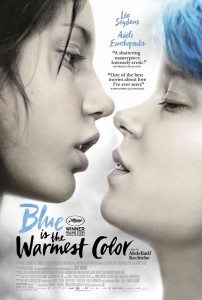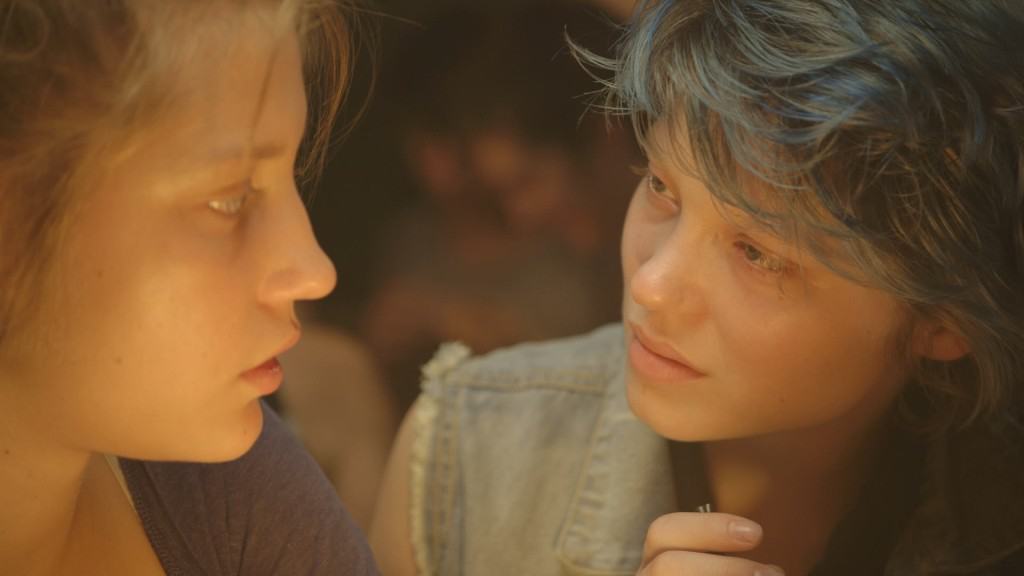
Release Date: October 25, 2013 (Limited)
Director: Abdellatif Kechiche
MPAA Rating: NC-17
Film Pulse Score: 8/10
Maurice Pialat’s 1983 masterpiece A Nous Amour may be an universally under recognized film today, but its highly revered as one of the best pieces of contemporary French cinema. The film took a young and undiscovered actress (a young Sandrine Bonnaire) into realms of familial tension and sexual exploration in a way that could be likened to a french take on the work of Cassavetes, and it’s deeply respected for the kind of realism it exposed in French culture, especially in terms of family and sexuality. In Abdellatif Kechiche’s film Blue is the Warmest Color (french title La Vie d’Adele), a similar exploration has again risen to the screen, in that it features a brilliant performance from a first time actress in a sexual coming of age story. This time it employs the power of raw sexuality, with little or no objection from its audience, and its won the Palm d’Or in celebration of that. What amazes me is that in each of these films, a first time actress is able to take on such a challenging role and succeed in dominating the screen. In fact, in Blue, you can feel the lust and desire in your pores.
The film begins in a french high school with teenagers reading from classic literature. We see a girl’s mouth centered in our attention as she reads the phrase “Je suis une femme” (I am a woman). The male teacher stops her from reading, and asks her to repeat the phrase with some renewed force, harkening a self referential tone from the director. After all, as he says, the student reading actually is a woman, and since it is the truth, why not read it like she understands that is the case. This phrase and the re-reading of it establishes the concern of the film’s journey, and after this initial scene, we will witness the experience of woman completely through the eyes of Adèle (Adèle Exarchopoulos), a teenager that is about to face the nature of first love. Adèle’s life is becoming more and more complicated. Her first boyfriend can’t satiate the feelings she discovers about sex and love. When crossing paths in the street with a mysteriously enchanting blue haired girl, Adèle begins to discover the nature of her appetite. She lusts after the girl while asleep in her childhood bedroom, and quickly arranges a moment to see her again in a bar “by chance.” She argues violently with friends at school when accused of being a lesbian. After all, she is only discovering that she is in love, what do her friends know about it anyway? Alongside Adèle, we set out on a story that is rich and complex, even with the focus remaining on the face of Adèle for upwards of half of a three hour film. The story is engaging, painful, and to be honest, it’s hot.

I knew I liked the film as I left the theater, but the longer I sat with it, I must admit it became more difficult to accept the film’s flaws. My largest criticism is that the need for aesthetic competes with being able to experience Adele’s vantage point, and this risks some very basic aspects of feminist film theory in a way that compromises the success of the film. To explain: The very first thing out of my mouth as I left the theater was “Her performance was astounding, so why didn’t I believe that she was actually in love with Emma (Léa Seydoux)?”. By focusing on Adele as though she is an object of beauty, as the camera often does, we are spun out of her experience and put into a new and more complicated vantage point. The camera sexualizes her constantly, (it does not do this with Emma). An obvious example is the shot of her taking a shower as though she is being watched, positioning her behind for the benefit of the viewer. It charges us, but it steps out of the reality of the film…after all, in this scene, she is alone, so who is she posing for? To half quote NY Times critic Manhola Dargis (who has been openly scrutinized for her misgivings on the film) “Does Adele fantasize about her own hot body?” Its a question I faced over an over in the film, and as the end credits rolled, I had already concluded that the success of the film would have been incredibly different, and stronger, if there could just be one ugly moment amongst the presentational, controlled, and fantastical images of two women playing two women in love. Adele is remarkably able to evoke a feeling of being destroyed on the screen but the camera simply works against her.

Even if the film itself is indulgent, the political tone of the film is the subtext. That particular aspect is introduced when the two girls are dining with each other’s families in separate scenes. Emma clearly comes from privilege, Adèle comes from the working class. Their ideas are different, their approach to life is different, and by the time Adele starts acting out on the inevitable loneliness this presents, Emma has already decided that their relationship is going to end. Emma’s inspiration has been transferred to a new muse, and Adele is too blind to see the forest for the trees. It’s worth noting that the actresses playing the roles of Adele and Emma come from the same social classes that they play, and are playing out threads of the same story as the film’s controversy makes headlines. Seydoux is an experienced actress and hails from one of the wealthiest families in France, and Exarchopoulos is a first timer, arrives from a working class family.
In the end, my questions for this film won’t be answered. We watch quietly as a relationship is discovered, blossoms, rages, and then dies. I wonder then, for a film that is about the life of Adele, what ever became of her? Who is she when not defined by her ‘appetite’? The camera isn’t interested in telling us, and unfortunately, seems to discard her just as Emma does in the final scenes. I cared for her more than this as I watched her turmoil, and it’s sad to let her go so unsatisfied. If “C’est la vie” is meant to say “that’s life, kid” (well close anyway), I hope, for both Adèle’s, that the end of the road presents a little less turmoil, and a little more love.






